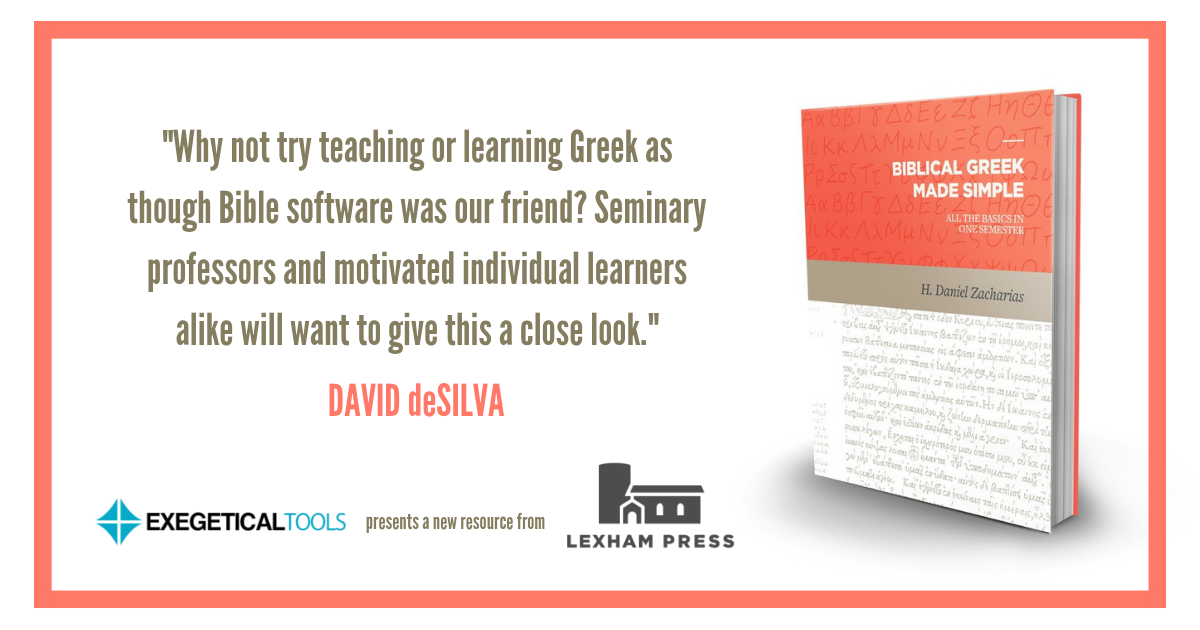It’s finally happened. You’ve reached the tipping point.
First, it was blogs about the passage you’re reading. Then, it was commentaries. But that wasn’t enough. You broke down and bought Bible software. You’re using the Strong’s concordance regularly, and you’re starting to remember the definitions of some of those Greek words.
But now, you’ve finally accepted that you have to do it. You have to learn Greek.
You’ve realized that there’s so much more than simple definitions. There are tenses, voices, cases, and semantic domains. There are figures of speech, and some words even have completely different meanings depending on their context!
But what are you to do? Perhaps you should pack up and move to seminary. Maybe you’ll earn a degree online. Both good options with numerous benefits.
But maybe that’s not a possibility, at least not right now.
Or maybe you’ve snuck into this blog post with years of Greek that you’ve—gasp!—forgotten.
Fortunately for you, there are abundant resources for a self-learner to pick up and retain (or regain) a knowledge of biblical Greek. However, that abundance can sometimes bring anxiety. How can you know which to use, or how to make the best use of them?
These questions are a huge part of why Exegetical Tools exists, and we want to present you in this post with a plan to understand and enjoy biblical Greek.
It’s not the only plan for teaching yourself Greek, and opinions certainly vary on best practices. However, this plan is designed for maximum impact in minimum months. In less than a year, diligent self-learners can grasp Greek grammar and syntax. Just as importantly, they can be equipped with the right practices and resources to continue learning for a lifetime and spending time daily in the Greek New Testament.
There are three phases to this plan that can easily be completed in under a year.
Phase One: Grammar with Biblical Greek Made Simple
So, you scroll over a word in the New Testament on Logos and notice that it’s a third-person singular nominative. You don’t know how Logos knows that the word is a third-person singular nominative, and you’re not 100% sure what that means.
Any Greek grammar will teach you to how to identify parts of speech. Memorization is imperative. However, with the tools available to you in Logos, you’ve got a leg up on this. With time, you’ll begin recognizing these differences with fewer aids, but they are always a click away in Bible software or a page-flip away in an interlinear Bible.
While many Greek grammars will emphasize identifying parts of speech, they might lack in explaining what these different parts mean. You’ll learn it all eventually, but there’s a steep learning curve. The temptation to never climb the curve might overcome you.
Enter Biblical Greek Made Simple.
Danny Zacharias and Lexham Press have designed a Greek grammar for those already utilizing the wealth of resources in Logos and hoping to make even better use of them (you can listen to a podcast episode about that). What many Greek grammars do in 9 or 10 months, Biblical Greek Made Simple does in 12 weeks. There’s no magic shortcut here, just a shift in priority. Biblical Greek Made Simple introduces students to all the paradigms necessary to identify different parts of speech but focuses on making sense of those parts of speech over identifying them without any aids.

Should you memorize all the paradigms and endings and learn to read your Greek New Testament with minimal help? Yes, and that will be part of your exercises in Biblical Greek Made Simple (and we’ve created a host of resources to help). But if you’re a self-learner, there is nothing more motivating than being able to see (some) immediate fruit in your study of the Bible because of your growing knowledge of Greek. You can’t microwave your education of a foreign language, but you can give yourself the maximum potential to stay on the path toward a lifelong engagement with the Greek New Testament.
The one-semester approach of Biblical Greek Made Simple is fine-tuned for exactly this. Though also made for one-semester seminary classes, Danny has included a multitude of helps for the self-learner, including an integrated workbook, functionality with Logos Bible Software, and even mobile apps for parsing and vocabulary.
So, here’s how this phase could look: Each week, start by watching the Exegetical Tools Basic Greek Videos that correspond to the subjects in your chapter of Biblical Greek Made Simple. Then, read through the chapter, utilize the extra resources mentioned, and practice your understanding with the provided exercises, excluding the “Second Time Around” sections. You should be gaining an understanding of the Greek language and the resources in your Bible software.
This is a fast and fantastic start to a lifelong journey in the Greek New Testament. But that’s not even half the year yet!
Phase Two: Syntax with Going Deeper with New Testament Greek
You may not have every single paradigm memorized by the time you finish Biblical Greek Made Simple, but you will already be reaping benefits in your study. However, things will start to solidify as you start grappling with syntax.
Grammar helps you to identify words and their meanings, based not only on the range of their definitions, but also on the packaging in which they’re presented. These are the differences between, for example, “We are going,” “They might go,” and “Go!” Each of these English phrases can be expressed in just one variation of a word in Greek.
Syntax, however, teaches you to discern the different functions of a word or phrase when placed in a particular situation within a sentence. It’s the difference between “We are going to the store” and “We are going to get sick.” The same phrase has two distinct (through related) meanings, depending on the rest of the sentence.
More than other Greek grammars, Biblical Greek Made Simple will have already introduced you to these categories. However, phase two is all about going deeper.
Each week, you’ll review Biblical Greek Made Simple. This should be a breeze, but it will help you to gain even more confidence in identifying parts of speech with fewer aids. You’ll complete the “Second Time Around” exercises to refresh and advance your knowledge of Greek grammar.
But while you’re solidifying grammar, you will also be going deeper with syntax.
Just as Biblical Greek Made Simple is a one-semester elementary Greek textbook, Going Deeper with New Testament Greek is a one-semester intermediate Greek textbook. In 15 weeks, the authors deliver on the promise in the title. You will gain a more in-depth understanding of the various categories of the different parts of speech and put those into practice by completing exercises straight from the text of Scripture. Your vocabulary will go deeper, too: Going Deeper teaches you every word that is used 15 times or more in the Greek New Testament. You’ll also be introduced to advanced Greek topics, like verbal aspect theory and discourse analysis.
With Biblical Greek Made Simple and Going Deeper with New Testament Greek, your grammar comprehension will grow even as you sharpen your knowledge of syntax. In 27 weeks of diligent study, you’ll have all the prerequisite knowledge to launch into a lifelong process of growing in your study of God’s Word in the Greek New Testament.
But you’re going to need the right tools.
Phase Three: Comprehension and Exegesis with Exegetical Tools and Daily Dose of Greek
You can now enjoy what would have been unwise or unfruitful when you first began your studies: interpreting the New Testament in its original language.
Keep Biblical Greek Made Simple and Going Deeper with New Testament Greek handy—you’ll be referring back to them from time to time (the charts from Going Deeper are a goldmine that you ought to download for quick reference).
But now it’s time for you to start exegeting the biblical text, and we’re here to help. Our Greek Reading Videos walk through a book of the New Testament, marking up the text on-screen as a Greek professor helps you parse, remember vocabulary, notice syntax, and learn about irregularities and quirks you may not have covered in the first two phases.
While Biblical Greek Made Simple helped you make use of aids to jump-start your Greek knowledge, these Greek Reading Videos aim to build your comprehension with less reliance on them. You’ll still have plenty of reason to use Bible software, but you’ll be able to use it more efficiently and with greater confidence.
While you’re working through the Greek New Testament at your own pace with Greek Reading Videos, you’ll want to be sure you’re staying sharp daily. Subscribe to Daily Dose of Greek from Rob Plummer—it’s exactly what it sounds like, and it comes highly recommended by Greek nerds all over. Read articles, listen to podcasts, and watch as your understanding of the issues at play in exegesis and linguistics grows.
Most importantly, read your Greek New Testament. Use exactly the aids you need to comprehend God’s Word in the original language and keep reading until you need fewer and fewer of them. Eventually, you’ll pick it up, read it, comprehend it, and delight in it.
Accelerate
This is just one way a self-learner can obtain a knowledge of biblical Greek, but I think it’s a good one. It’s simple, deep, and quick (less than a year!), but it sets you up to know what you need to know when you need to know it. There are no shortcuts to a lifelong journey, but there are faster vehicles to take you to the main stretch of road. This plan is no walk in the park, but it will lead to a lifetime of fruitful study for the diligent student.
What are you waiting for?

